Motion In A Straight Line
Distance: The actual length of the path travelled by the particle.
Displacement: Change in position in a particular direction (or the minimum distance between 2 points).
Speed = \(\frac{\text { distance }}{\text { time }}\)
Velocity = \(\frac{\text { displacement }}{\text { time }}\)
Avg. velocity = \(\frac{\text { total displacement }}{\text { total time }}\)
⇒ \(=\frac{x_f-x_i}{t_f-t_i}=\frac{\Delta x}{\Delta t}\)
Where xf is the final position, xi is the initial position, f is the final time and h is the initial time.
Read And Learn More: NEET Physics Notes
Instantaneous Velocity
Limiting value of average velocity is called instantaneous velocity.
⇒ \(\mathrm{v}=\lim _{\Delta \mathrm{t} \rightarrow 0} \frac{\Delta \mathrm{x}}{\Delta \mathrm{t}}=\frac{\mathrm{dv}}{\mathrm{dt}}\)
The slope of the x – t graph is the average velocity.
The slope of the v – t graph is the acceleration
The area under the v – t graph is displacement.
Kinematic equations of motion for a body moving with uniform acceleration
NEET Physics Motion in a Straight Line Important Formulas
v= u +at
x= ut + ½ at2
v2 = u2 + 2ax
x= \(\left(\frac{\mathrm{u}+\mathrm{v}}{2}\right) \mathrm{t}\)
Sn = \(\mathrm{u}+\frac{\mathrm{a}}{2}(2 \mathrm{n}-1)\)
a= v \(v \frac{d v}{d x}\)
Where, u = initial velocity, v = final velocity, a = acceleration, t = time, x Sn= distance travelled in nth= displacement and second

Calculation of distance travelled in nth second:
Sn = Distance travelled in ‘n’ seconds – distance travelled in ‘n – 1’ seconds
Sn = Xn- Xn-1
= \(\mathrm{un}+\frac{1}{2} \mathrm{an}^2-\left[\mathrm{u}(\mathrm{n}-1)+\frac{1}{2} \mathrm{a}(\mathrm{n}-1)^2\right]\)
= \(\mathrm{un}+\frac{1}{2} a n^2-\left[\mathrm{un}-\mathrm{u}+\frac{1}{2} a\left(\mathrm{n}^2+1-2 \mathrm{n}\right)\right]\)
= \(\mathrm{un}+\frac{1}{2} \mathrm{an}^2-\left[\mathrm{un}-\mathrm{u}+\frac{1}{2} \mathrm{an}^2+\frac{\mathrm{a}}{2}-\mathrm{an}\right]\)
= \(\mathrm{un}+\frac{1}{2} \mathrm{an}^2-\mathrm{un}+\mathrm{u}-\frac{1}{2} \mathrm{an}^2-\frac{\mathrm{a}}{2}+\text { an }\)
= \(\mathrm{u}+\frac{\mathrm{a}}{2}(2 \mathrm{n}-1)\)
Best Short Notes for Motion in a Straight Line NEET
Note:
x = \(\mathrm{ut}+\frac{1}{2} \mathrm{at}^2\)
x= \((\mathrm{v}-\mathrm{at}) \mathrm{t}+\frac{1}{2} \mathrm{at}^2\)
x= \(\mathrm{vt}-\mathrm{at}^2+\frac{1}{2} \mathrm{at}^2\)
x= \(\mathrm{vt}-\frac{1}{2} a \mathrm{t}^2\)
[ v= u +at, u= v-at]
(This equation can be used to find displacement (x) if final velocity (v) is known).
If a particle travels half the distance with velocity v1 and the remaining velocity with v2, then the average velocity is given by
⇒ \(\bar{v}=\frac{2 v_1 v_2}{v_1+v_2}\)
If a particle travels with the velocity with vx for the first half-time, and the remaining half-time with v2, then the average velocity is given by
⇒ \(\overline{\mathrm{v}}=\frac{\mathrm{v}_1+\mathrm{v}_2}{2}\)
Basci Formulae Of Diffrrentiiation
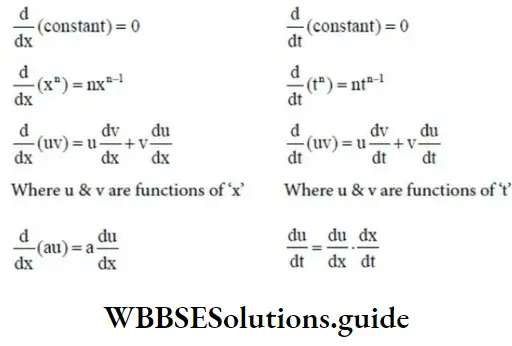
Motion in a Straight Line NEET Important Questions and Answers
Where ‘a’ is a constant and ‘u’ is a function of ‘x’
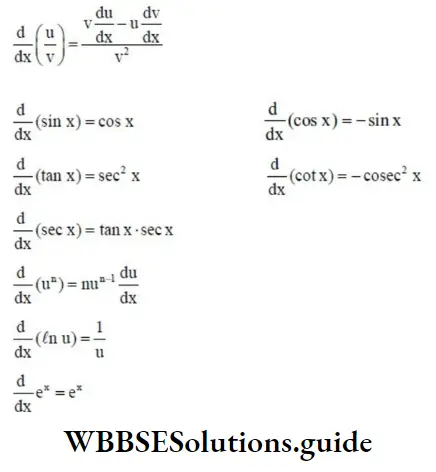
Basic Formulae of Integration:
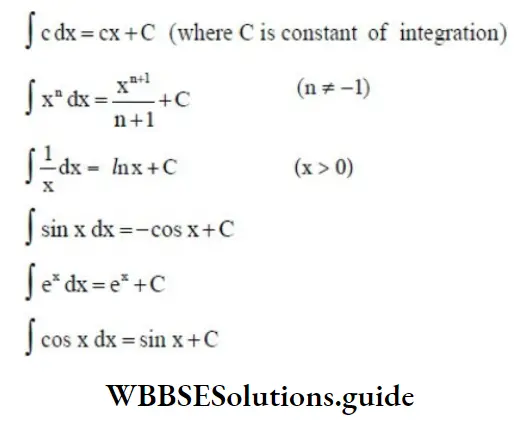
NEET Physics Motion in a Straight Line MCQs with Solutions
Definite integration
⇒ \(\int_a^b f(x) d x=\left.g(x)\right|_a ^b=g(b)-g(a)\)
Illustration:
Suppose f(x) = x2. Determine the value of the definite integral from x = 1 to x = 2.
⇒ \(\int_1^2 x^2 d x=\left[\frac{x^3}{3}\right]_1^2=\frac{8}{3}-\frac{1}{3}=\frac{7}{3}\)
Example:
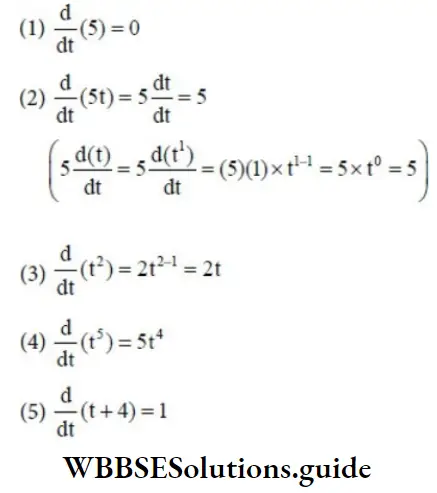
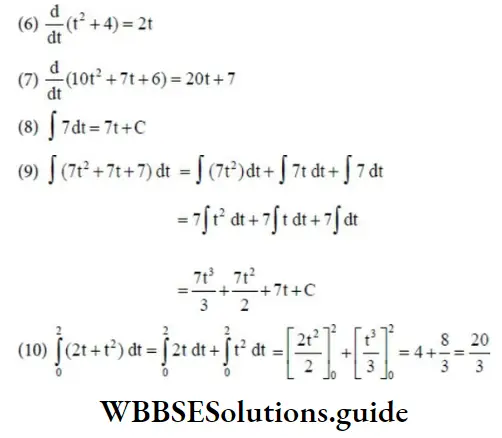
Example:
The position of an object moving along the x-axis is given by x = a + bt2 where a = 8.5 m, b = 2.5 ms-2 and t is measured in seconds. What is its velocity at t = 0s and t = 2s. What is the average velocity between t = 2s and t = 4s?
Solution:
Given
The position of an object moving along the x-axis is given by x = a + bt2 where a = 8.5 m, b = 2.5 ms-2 and t is measured in seconds.
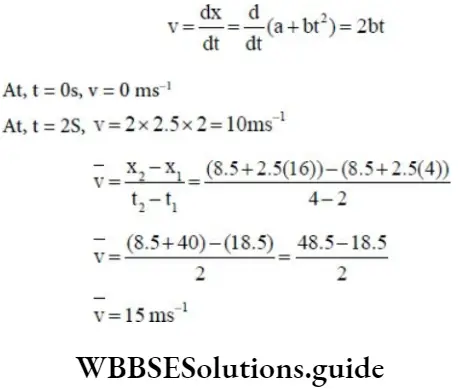
Equations of motion for constant acceleration using the method of calculus
Consider a body starts with initial velocity ‘u’ (at t=0) and moves with a constant acceleration ‘a’ and attains a speed v in time ‘t’.w.k.t.,
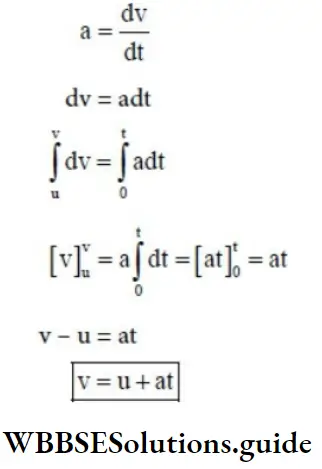
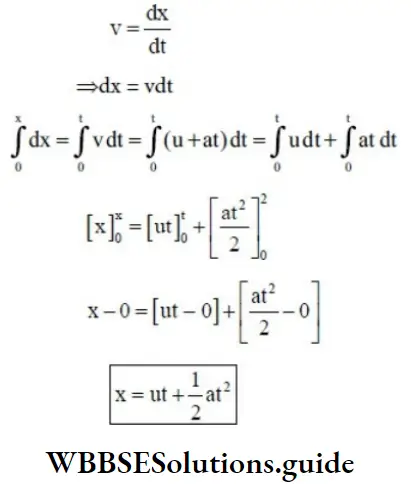
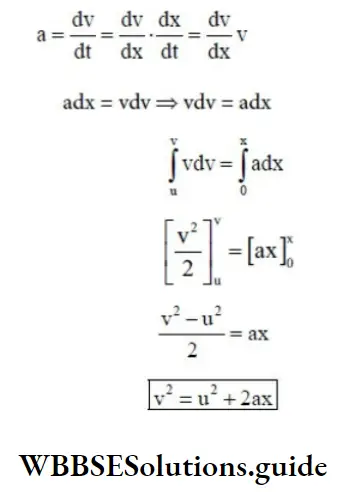
Sign Convention
“Upward Direction Is Taken + Y–axis”
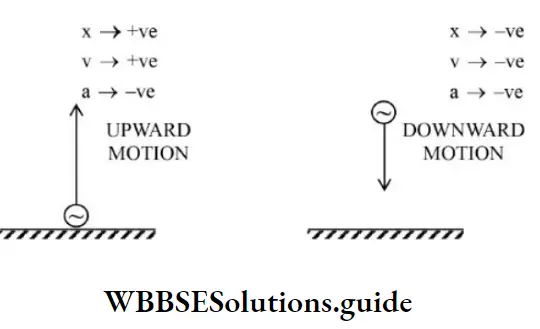
Graphs of Motion in a Straight Line NEET Notes
Free Fall:
Consider a body dropped from the top of the building at t = 0s (i.e ., u= 0 m/s-2) and g= – 10 ms-2)
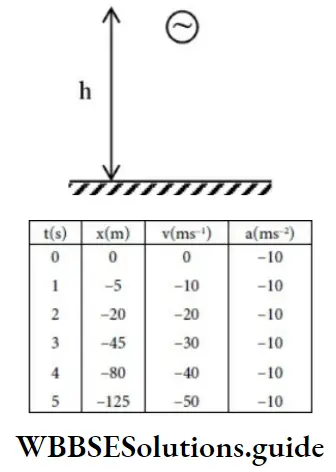
The ratio of the distance travelled in 1 second, 2 seconds, 3 seconds and so on are in the ratio, x1s: x2s: x3s= 1 : 4 : 9 := 12 : 22 : 32:
The ratio of the distance travelled in 1st second, 2nd second, 3rd second and so on are in the ratio, x1n: x2nd: x3RD …………= 1:3:9:………(Galileo’s law of odd numbers)
x-t, v-t and a-t graphs in the case of free fall are given below
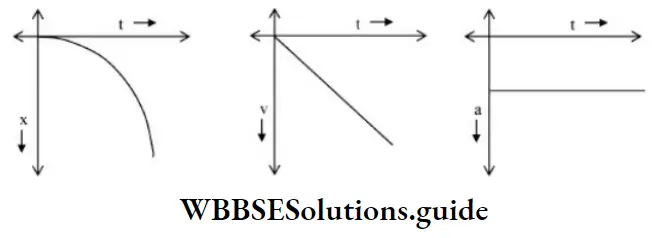
A car starts from rest and acquires a speed v with uniform acceleration a. Then it comes to stop with uniform retardation β.
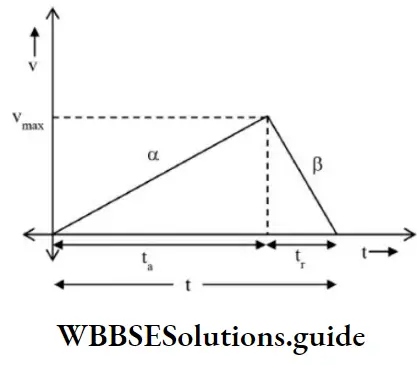
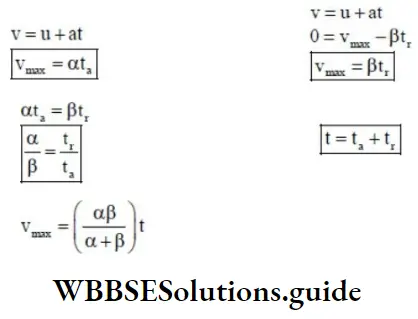
NEET Study Material for Motion in a Straight Line Chapter
Distance Travelled in time ‘t’
x= \(x=\frac{1}{2}\left(\frac{\alpha \beta}{\alpha+\beta}\right) t^2\)
If a body is dropped from a height ‘h
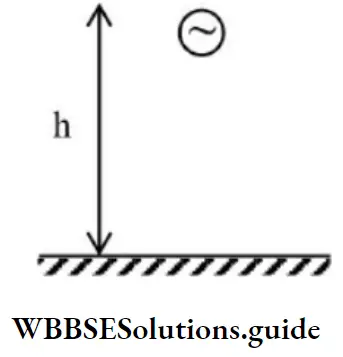
The time required for the body to reach the ground is
t= \(\sqrt{\frac{2 \mathrm{~h}}{\mathrm{~g}}}\)
The velocity acquired by the body on reaching the ground is given by
v= \(\sqrt{2 \mathrm{gh}}\)
Note:
Time of ascent (ta) = Time of descent (td)
Time of flight T = ta + td
T= \(\frac{\mathrm{u}}{\mathrm{g}}+\frac{\mathrm{u}}{\mathrm{g}}\)
T= \(\frac{2 \mathrm{u}}{\mathrm{g}}\)
The stopping distance of vehicles moving with constant retardation is given by
⇒ \(D_s=\frac{u^2}{2 a}\)
i.e., the stopping distance is directly proportional to the square of the initial speed.
